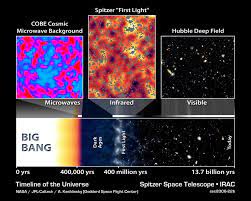The Cosmic Microwave Background: Unlocking Clues to the Early Universe.
The cosmic microwave background (CMB) is a faint glow of electromagnetic radiation that fills the entire observable universe. It is the oldest light we can observe and is a crucial tool for understanding the early universe.
Discovery of the Cosmic Microwave Background
The discovery of the CMB is one of the greatest scientific achievements of the 20th century. In 1964, two radio astronomers, Arno Penzias and Robert Wilson, were studying radio waves emitted by the Milky Way when they noticed an excess of noise in their instrument. They initially thought the noise was caused by bird droppings on their antenna, but after cleaning it, they still observed the same excess noise. It was later determined that the excess noise was actually the CMB, leftover radiation from the Big Bang.
Characteristics of the Cosmic Microwave Background
The CMB is a nearly uniform background of radiation with a temperature of approximately 2.7 Kelvin. It has a blackbody spectrum, which means that its energy is distributed evenly across all wavelengths. The spectrum of the CMB has been measured with great precision and is consistent with the predictions of the Big Bang model.
The CMB is also polarized, meaning that the orientation of its electric field oscillations varies across the sky. This polarization pattern contains valuable information about the early universe and the processes that occurred during its formation.
Origins of the Cosmic Microwave Background
The CMB was created about 380,000 years after the Big Bang, when the universe had cooled enough for neutral atoms to form. Prior to this time, the universe was filled with a hot, dense plasma of charged particles that interacted strongly with radiation, making it opaque. But as the universe cooled and expanded, the radiation was able to escape and travel freely through space, eventually cooling to its current temperature.
Clues to the Early Universe
The CMB is a powerful tool for understanding the early universe. Its uniformity across the sky provides evidence for the cosmological principle, which states that the universe is homogeneous and isotropic on large scales. The small fluctuations in temperature and polarization of the CMB contain information about the density and composition of the universe at the time of recombination, which can be used to test cosmological models.
The CMB also provides evidence for the inflationary universe model, which proposes that the universe underwent a period of rapid expansion shortly after the Big Bang. This model predicts a specific pattern of temperature fluctuations in the CMB that has been observed by several experiments.
Conclusion
The cosmic microwave background is a crucial tool for understanding the early universe. Its discovery has revolutionized our understanding of the cosmos and has provided valuable insights into the processes that occurred during the formation and evolution of the universe. Ongoing observations and analyses of the CMB are helping to refine our understanding of the universe and its origins.






0 Comments:
Post a Comment
Subscribe to Post Comments [Atom]
<< Home